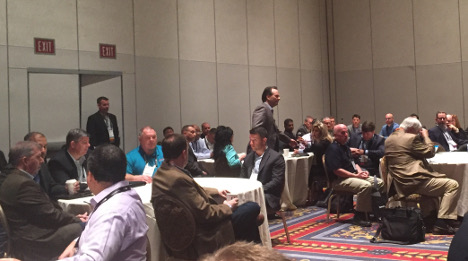Disrupting remarketing through data

RMS Automotive's Nick Peluso, center, leads a discussion on remarketing disruption at the CAR Conference in March.
By subscribing, you agree to receive communications from Auto Remarketing and our partners in accordance with our Privacy Policy. We may share your information with select partners and sponsors who may contact you about their products and services. You may unsubscribe at any time.
LAS VEGAS –
What is the difference between innovation and disruption? Is there a difference at all? What areas of the wholesale remarketing industry are being disrupted, and what areas are ripe for change?
Those are some of the questions posed during a session here at the Conference of Automotive Remarketing, and undoubtedly on the minds of many in the auction and wholesale auto industry at large.
The consumer-facing side of the car business — online retailers like Carvana, autonomous vehicles, ride- and car-sharing services — may get the lion’s share of attention when talk of disruption and innovation surfaces.
But there’s plenty to go around on the wholesale side, too, as was evident in discussions during the interactive session led by Mike Broe of AutoIMS and Nick Peluso of RMS Automotive.
Online sales, mobile auctions, dealer group-owned auctions, transportation/logistics networks all came up during a wide-ranging, back-and-forth conversation between presenters and attendees alike.
“No doubt, we are ripe for disruption,” Peluso said during the session.
Subscribe to Auto Remarketing to stay informed and stay ahead.
By subscribing, you agree to receive communications from Auto Remarketing and our partners in accordance with our Privacy Policy. We may share your information with select partners and sponsors who may contact you about their products and services. You may unsubscribe at any time.
And his company is among those doing some of the disrupting. But perhaps not in the way you might think right off the bat.
During the presentation, Peluso asked attendees where they believe disruption is going to happen in the wholesale space. Auto Remarketing posed the same question to him afterward.
The focal point of disruption in remarketing has been on “how decisions are made with vehicle remarketing and how portfolios are managed,” he said.
In today’s industry, Peluso explained, “the remarketing department lives and breathes based on a decision that’s made around new-car sales. We need to sell more cars, so we’re going to pull these ahead, we’re going to put incentives on cars to get lower payments.
“And the remarketing department ends up with a box of toys that they have to sell,” he said. “And they’re heroes or goats, based on how they perform.”
However, “they had no impact in establishing the residual value on the car,” Peluso said.
“I think the disruption is going to start to come in with data,” he said. “Data and analytics and tools that are being created to help people that have large fleets. Help (them) better understand how their portfolio is performing down to the VIN-specific car and what they should do with it — extend it, pull it forward, move it somewhere — so they can get more in line with what it’s on the books for.
“And then remarketing becomes less of a guessing game, if you know you’re in a positive or a negative position,” Peluso said. “It may not change the way they go about it, but they’ll have better insights into what the outcome will be, versus some guess.”
And that is exactly how RMS — which works primarily with automaker captives, but really “anybody that has a large fleet” — is aiming to shake things up a bit on the wholesale side.
They aim to change the way consignors manage their portfolios by providing analytics into the decision process.
Peluso gives this example: off-lease portfolios. Say the grounding dealer doesn’t buy the vehicle, and the car is offered to the captive’s franchised dealers.
“But then something has to happen. Today that car then gets shipped to an auction. It’s normally shipped to the closest auction,” he said.
“What if we can insert analytics and data at the point of grounding to help determine that decision?” he said. “Should it just not even be offered? Is that car in such bad shape that it’s not CPO-ready or CPO-available, and a franchised dealer would never buy it?
“Should it be sent immediately to the auction, and not sit on the dealer’s lot for the three to seven days?” Peluso said. “Should it be offered to a different group of dealers, because they buy that type of car?
“Inserting that information earlier in the cycle is going to help reduce depreciation. It’s going to help improve cycle times. And depreciation is going to be the enemy everybody’s fighting over the next three years, at least.”
Not that the “golden gut” approach — i.e., using your instincts — should be taken out of the equation, he said.
“But when you bring data and analytics along with the ‘golden gut,’ you’ve got the best of both science and art working together,” Peluso said. “That’s where I think the future’s going to be, not the way it’s been operating for the past 30 years that I’ve seen it.”


